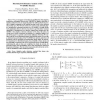Free Online Productivity Tools
i2Speak
i2Symbol
i2OCR
iTex2Img
iWeb2Print
iWeb2Shot
i2Type
iPdf2Split
iPdf2Merge
i2Bopomofo
i2Arabic
i2Style
i2Image
i2PDF
iLatex2Rtf
Sci2ools
71
Voted
TSP
2008
2008
Theoretical Performance Analysis of the W-ABORT Detector
In a recent paper we introduced a modification of the adaptive beamformer orthogonal rejection test (ABORT) for adaptive detection of signals in unknown noise, by supposing under the null hypothesis the presence of signals orthogonal to the nominal steering vector in the whitened observation space. We will refer to this new receiver as the whitened adaptive beamformer orthogonal rejection test (W-ABORT). Through Monte Carlo simulations this new detector was shown to provide better rejection capabilities of mismatched (e.g., sidelobe) signals than existing ones, like ABORT or the adaptive coherence estimator (ACE), but at the price of a certain loss in terms of detection of matched (i.e., mainlobe) signals. The aim of this paper is to provide a theoretical validation of this fact. We consider both the case of distributed targets and point-like targets. We provide a statistical characterization of the W-ABORT test statistic, under the null hypothesis, and for matched and mismatched signa...
Related Content
| Added | 16 Dec 2010 |
| Updated | 16 Dec 2010 |
| Type | Journal |
| Year | 2008 |
| Where | TSP |
| Authors | Francesco Bandiera, Olivier Besson, Danilo Orlando, Giuseppe Ricci |
Comments (0)

